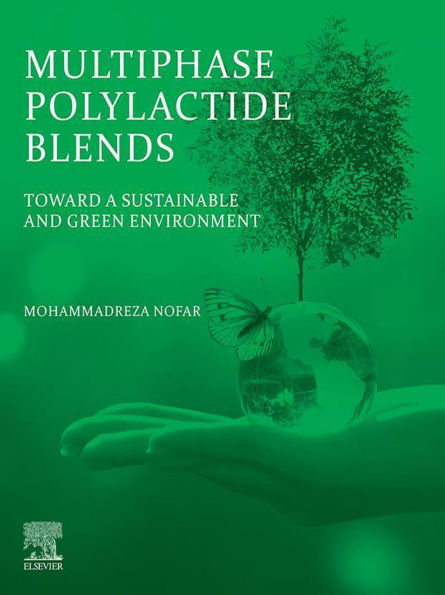Multiphase Polylactide Blends: Toward a Sustainable and Green Environment guides the reader through fundamentals, science, preparation, and key areas of innovation in polylactide (PLA) blends. Bio-based polymers, and notably PLA, have not only gained increasing interest as a more sustainable alternative but also bring challenges in terms of mechanical, rheological, thermal and physical properties, processability, shapability, and foamability. The use of blends looks to address these, with the development of new types of economically viable and environmentally friendly systems. This is a valuable book for academic researchers, scientists, and graduate students across bio-based polymers, polymer science, chemistry, and materials science, as well as engineers, R&D professionals, and all those in industry with interest in PLA-based blends, biopolymers, and sustainable materials and products. More specifically, the first three chapters of this book overview the fundamentals of thermoplastic polymers, polymer blends, and structure and properties of PLA. These chapters could technically be used as a valuable textbook on the noted topics. The rest of the chapters inclusively study the fundamentals, investigations, and achievements in PLA-based blends with various types of polymers. These include miscible blends of poly L-lactide and poly D-lactide, binary immiscible/miscible blends of PLA with other thermoplastics and elastomers, PLA-based ternary blends and blend nanocomposites, as well as PLA-based blend foams. Overall, this book provides a thorough and critical overview of the state of the art in PLA-based blends, including significant past and recent advances, with the aim of supporting and shaping further research and industrial application of these materials for the development of a green and sustainable future. - Overviews the fundamentals of thermoplastic polymers, polymer blends, and the structure and properties of PLA. - Provides detailed coverage of the fundamentals and science of PLA blends, including phase miscibility, thermal and mechanical properties, interface and rheological properties, the use of compatibilizers, and phase morphological analysis. - Offers a thorough critical overview of the state of the art in processing and development of PLA-based blends, addressing key challenges and future perspectives. - Covers the latest advances, including PLA-based ternary blends, blend nanocomposites, and PLA-based blend microcellular foams.
1138764780
Multiphase Polylactide Blends: Toward a Sustainable and Green Environment
Multiphase Polylactide Blends: Toward a Sustainable and Green Environment guides the reader through fundamentals, science, preparation, and key areas of innovation in polylactide (PLA) blends. Bio-based polymers, and notably PLA, have not only gained increasing interest as a more sustainable alternative but also bring challenges in terms of mechanical, rheological, thermal and physical properties, processability, shapability, and foamability. The use of blends looks to address these, with the development of new types of economically viable and environmentally friendly systems. This is a valuable book for academic researchers, scientists, and graduate students across bio-based polymers, polymer science, chemistry, and materials science, as well as engineers, R&D professionals, and all those in industry with interest in PLA-based blends, biopolymers, and sustainable materials and products. More specifically, the first three chapters of this book overview the fundamentals of thermoplastic polymers, polymer blends, and structure and properties of PLA. These chapters could technically be used as a valuable textbook on the noted topics. The rest of the chapters inclusively study the fundamentals, investigations, and achievements in PLA-based blends with various types of polymers. These include miscible blends of poly L-lactide and poly D-lactide, binary immiscible/miscible blends of PLA with other thermoplastics and elastomers, PLA-based ternary blends and blend nanocomposites, as well as PLA-based blend foams. Overall, this book provides a thorough and critical overview of the state of the art in PLA-based blends, including significant past and recent advances, with the aim of supporting and shaping further research and industrial application of these materials for the development of a green and sustainable future. - Overviews the fundamentals of thermoplastic polymers, polymer blends, and the structure and properties of PLA. - Provides detailed coverage of the fundamentals and science of PLA blends, including phase miscibility, thermal and mechanical properties, interface and rheological properties, the use of compatibilizers, and phase morphological analysis. - Offers a thorough critical overview of the state of the art in processing and development of PLA-based blends, addressing key challenges and future perspectives. - Covers the latest advances, including PLA-based ternary blends, blend nanocomposites, and PLA-based blend microcellular foams.
230.0
In Stock
5
1

Multiphase Polylactide Blends: Toward a Sustainable and Green Environment
404
Multiphase Polylactide Blends: Toward a Sustainable and Green Environment
404Related collections and offers
230.0
In Stock

Product Details
| ISBN-13: | 9780128241516 |
|---|---|
| Publisher: | Elsevier Science |
| Publication date: | 07/15/2021 |
| Sold by: | Barnes & Noble |
| Format: | eBook |
| Pages: | 404 |
| File size: | 127 MB |
| Note: | This product may take a few minutes to download. |
About the Author
What People are Saying About This
From the B&N Reads Blog
